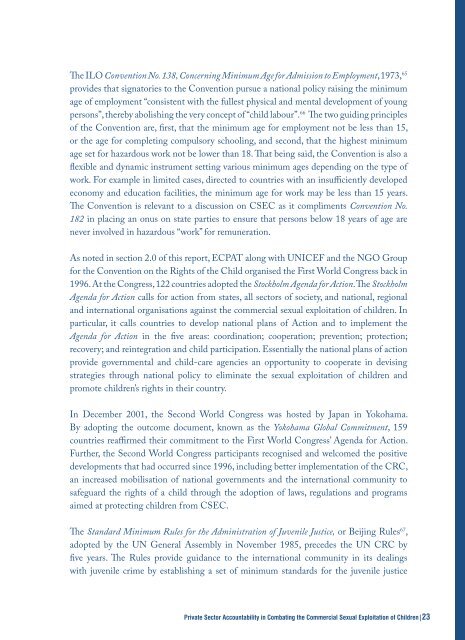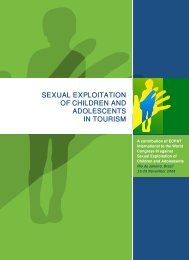elations. It affirms women’s rights <strong>to</strong> acquire, change or reta<strong>in</strong> <strong>the</strong>ir nationality and <strong>the</strong>nationality of <strong>the</strong>ir children. States parties also agree <strong>to</strong> take appropriate measures aga<strong>in</strong>stall forms of traffick<strong>in</strong>g <strong>in</strong> women and exploitation of women. Its application <strong>to</strong> CSEC isnot so straightforward. Some academics 60 argue that s<strong>in</strong>ce “women” is not def<strong>in</strong>ed <strong>in</strong> <strong>the</strong>Convention, its articles are equally applicable <strong>to</strong> <strong>the</strong> girl child as well. In this respect, <strong>the</strong>sections on traffick<strong>in</strong>g and exploitation are germane <strong>to</strong> this discussion.The Convention on Consent <strong>to</strong> Marriage, M<strong>in</strong>imum Age for Marriage and Registration forMarriages 61 was opened for signature and ratification by <strong>the</strong> General Assembly resolution1763 A (XVII) <strong>in</strong> November 1962 and entered <strong>in</strong><strong>to</strong> force <strong>in</strong> December 1964. TheConvention conta<strong>in</strong>s only 10 articles, few of which have implications for CSEC cases.Article 1 states, “No marriage shall be legally entered <strong>in</strong><strong>to</strong> without <strong>the</strong> full and free consen<strong>to</strong>f both parties, such consent <strong>to</strong> be expressed by <strong>the</strong>m <strong>in</strong> person after due publicity and <strong>in</strong><strong>the</strong> presence of <strong>the</strong> authority competent <strong>to</strong> solemnize <strong>the</strong> marriage and of witnesses, asprescribed by law and Article 2 expla<strong>in</strong>s, “States Parties <strong>to</strong> <strong>the</strong> present Convention shalltake legislative action <strong>to</strong> specify a m<strong>in</strong>imum age for marriage. No marriage shall be legallyentered <strong>in</strong><strong>to</strong> by any person under this age, except where a competent authority has granteda dispensation as <strong>to</strong> age, for serious reasons, <strong>in</strong> <strong>the</strong> <strong>in</strong>terest of <strong>the</strong> <strong>in</strong>tend<strong>in</strong>g spouses.” In <strong>the</strong>case of child marriage, <strong>the</strong> Convention may be applicable.The Declaration on <strong>the</strong> Elim<strong>in</strong>ation of Violence aga<strong>in</strong>st Women 62 br<strong>in</strong>gs <strong>to</strong> light <strong>the</strong> role ofwomen <strong>in</strong> society by attempt<strong>in</strong>g <strong>to</strong> establish a global consensus on rais<strong>in</strong>g <strong>the</strong> status ofwomen. In addition, it calls on states <strong>to</strong> take steps <strong>to</strong> promote social policies aimed atelim<strong>in</strong>at<strong>in</strong>g gender-based violence <strong>in</strong> which case girl children are particularly vulnerable.The declaration identifies violence typically experienced both with<strong>in</strong> <strong>the</strong> family and with<strong>in</strong><strong>the</strong> general community, such as sexual abuse and assault, as well as traffick<strong>in</strong>g <strong>in</strong> womenand forced prostitution.The ILO Convention No. 182 63 became <strong>the</strong> first International Labour Organisationconvention <strong>to</strong> be unanimously adopted by <strong>the</strong> 174 member states of <strong>the</strong> ILO <strong>in</strong> June 1999.The Convention provides def<strong>in</strong>itions of <strong>the</strong> worst forms of child labour 64 that <strong>in</strong>clude,<strong>in</strong>ter alia: All forms of slavery, traffick<strong>in</strong>g, child prostitution, child pornography; use ofchildren for illicit activities, such as for <strong>the</strong> production and traffick<strong>in</strong>g of drugs; and us<strong>in</strong>gchildren for any work, which, by its nature or <strong>the</strong> circumstances <strong>in</strong> which it is carried out,are likely <strong>to</strong> harm <strong>the</strong> health, safety and morals of children. The Convention represents <strong>the</strong><strong>in</strong>ternational communities’ effort <strong>to</strong> def<strong>in</strong>e as law types of labour which children below <strong>the</strong>age of 18 should never be subjected <strong>to</strong>.22|Private Sec<strong>to</strong>r Accountability <strong>in</strong> Combat<strong>in</strong>g <strong>the</strong> Commercial Sexual Exploitation of <strong>Child</strong>ren
The ILO Convention No. 138, Concern<strong>in</strong>g M<strong>in</strong>imum Age for Admission <strong>to</strong> Employment, 1973, 65provides that signa<strong>to</strong>ries <strong>to</strong> <strong>the</strong> Convention pursue a national policy rais<strong>in</strong>g <strong>the</strong> m<strong>in</strong>imumage of employment “consistent with <strong>the</strong> fullest physical and mental development of youngpersons”, <strong>the</strong>reby abolish<strong>in</strong>g <strong>the</strong> very concept of “child labour”. 66 The two guid<strong>in</strong>g pr<strong>in</strong>ciplesof <strong>the</strong> Convention are, first, that <strong>the</strong> m<strong>in</strong>imum age for employment not be less than 15,or <strong>the</strong> age for complet<strong>in</strong>g compulsory school<strong>in</strong>g, and second, that <strong>the</strong> highest m<strong>in</strong>imumage set for hazardous work not be lower than 18. That be<strong>in</strong>g said, <strong>the</strong> Convention is also aflexible and dynamic <strong>in</strong>strument sett<strong>in</strong>g various m<strong>in</strong>imum ages depend<strong>in</strong>g on <strong>the</strong> type ofwork. For example <strong>in</strong> limited cases, directed <strong>to</strong> countries with an <strong>in</strong>sufficiently developedeconomy and education facilities, <strong>the</strong> m<strong>in</strong>imum age for work may be less than 15 years.The Convention is relevant <strong>to</strong> a discussion on CSEC as it compliments Convention No.182 <strong>in</strong> plac<strong>in</strong>g an onus on state parties <strong>to</strong> ensure that persons below 18 years of age arenever <strong>in</strong>volved <strong>in</strong> hazardous “work” for remuneration.As noted <strong>in</strong> section 2.0 of this report, ECPAT along with UNICEF and <strong>the</strong> NGO Groupfor <strong>the</strong> Convention on <strong>the</strong> Rights of <strong>the</strong> <strong>Child</strong> organised <strong>the</strong> First World Congress back <strong>in</strong>1996. At <strong>the</strong> Congress, 122 countries adopted <strong>the</strong> S<strong>to</strong>ckholm Agenda for Action. The S<strong>to</strong>ckholmAgenda for Action calls for action from states, all sec<strong>to</strong>rs of society, and national, regionaland <strong>in</strong>ternational organisations aga<strong>in</strong>st <strong>the</strong> commercial sexual exploitation of children. Inparticular, it calls countries <strong>to</strong> develop national plans of Action and <strong>to</strong> implement <strong>the</strong>Agenda for Action <strong>in</strong> <strong>the</strong> five areas: coord<strong>in</strong>ation; cooperation; prevention; protection;recovery; and re<strong>in</strong>tegration and child participation. Essentially <strong>the</strong> national plans of actionprovide governmental and child-care agencies an opportunity <strong>to</strong> cooperate <strong>in</strong> devis<strong>in</strong>gstrategies through national policy <strong>to</strong> elim<strong>in</strong>ate <strong>the</strong> sexual exploitation of children andpromote children’s rights <strong>in</strong> <strong>the</strong>ir country.In December 2001, <strong>the</strong> Second World Congress was hosted by Japan <strong>in</strong> Yokohama.By adopt<strong>in</strong>g <strong>the</strong> outcome <strong>document</strong>, known as <strong>the</strong> Yokohama Global Commitment, 159countries reaffirmed <strong>the</strong>ir commitment <strong>to</strong> <strong>the</strong> First World Congress’ Agenda for Action.Fur<strong>the</strong>r, <strong>the</strong> Second World Congress participants recognised and welcomed <strong>the</strong> positivedevelopments that had occurred s<strong>in</strong>ce 1996, <strong>in</strong>clud<strong>in</strong>g better implementation of <strong>the</strong> CRC,an <strong>in</strong>creased mobilisation of national governments and <strong>the</strong> <strong>in</strong>ternational community <strong>to</strong>safeguard <strong>the</strong> rights of a child through <strong>the</strong> adoption of laws, regulations and programsaimed at protect<strong>in</strong>g children from CSEC.The Standard M<strong>in</strong>imum Rules for <strong>the</strong> Adm<strong>in</strong>istration of Juvenile Justice, or Beij<strong>in</strong>g Rules 67 ,adopted by <strong>the</strong> UN General Assembly <strong>in</strong> November 1985, precedes <strong>the</strong> UN CRC byfive years. The Rules provide guidance <strong>to</strong> <strong>the</strong> <strong>in</strong>ternational community <strong>in</strong> its deal<strong>in</strong>gswith juvenile crime by establish<strong>in</strong>g a set of m<strong>in</strong>imum standards for <strong>the</strong> juvenile justicePrivate Sec<strong>to</strong>r Accountability <strong>in</strong> Combat<strong>in</strong>g <strong>the</strong> Commercial Sexual Exploitation of <strong>Child</strong>ren|23
- Page 5 and 6: PRIVATE SECTOR ACCOUNTABILITYIN COM
- Page 7 and 8: 3. Travel and Tourism Sub-Sector 63
- Page 9 and 10: Executive SummarySince the First an
- Page 11 and 12: from the sale of child pornography
- Page 13 and 14: 1.1 Defining Commercial Sexual Expl
- Page 15 and 16: The issue of commercial sexual expl
- Page 17 and 18: 1.2.1 Transnational and multination
- Page 19 and 20: offer stronger protections against,
- Page 21 and 22: 1.3 Defining Corporate Social Respo
- Page 23 and 24: Parliament passed a law requiring a
- Page 25 and 26: 2. International Standards and the
- Page 27 and 28: In terms of international law, the
- Page 29: alia: establish the grounds for cri
- Page 33 and 34: 2.4 Existing Legal Mechanisms to En
- Page 35 and 36: 2.4.2 Existing mechanisms for regul
- Page 37 and 38: Governments play an auxiliary role
- Page 39: lack of ) monitoring and enforcemen
- Page 42 and 43: who follow relevant international l
- Page 44 and 45: the Commentary references the rule
- Page 46 and 47: 2.4.2.1.2.1 Tripartite DeclarationT
- Page 48 and 49: Unlike the preceding sections, whic
- Page 50 and 51: A major criticism of the Tripartite
- Page 52 and 53: MNEs are asked to respect worker’
- Page 54 and 55: Guidelines voluntary, but non-OECD
- Page 56 and 57: An alternative to the above is to r
- Page 58 and 59: freedom from state interference in
- Page 60 and 61: During the Nuremburg Tribunals, Ger
- Page 62 and 63: ATCA expanded liability for interna
- Page 64 and 65: Pursuant to the holding in Kadic re
- Page 66 and 67: The Court could establish jurisdict
- Page 68 and 69: likely come across similar obstacle
- Page 70 and 71: ecognised by customary internationa
- Page 72 and 73: The report draws together a number
- Page 74 and 75: means of fostering international pe
- Page 76 and 77: a resolution, as well, in which it
- Page 78 and 79: The Swedish document was originally
- Page 80 and 81:
services are designed to combat chi
- Page 82 and 83:
into contact with individuals who c
- Page 84 and 85:
children’s perception of the worl
- Page 86 and 87:
advertisement. The European adverti
- Page 88 and 89:
high-profile case in the US where a
- Page 90 and 91:
child actors have gone on in adulth
- Page 92 and 93:
5. New Technologies Sub-Sector5.1 C
- Page 94 and 95:
North American cases illustrate how
- Page 96 and 97:
With the advent of the social netwo
- Page 98 and 99:
up to $US 500 if they violate the c
- Page 100 and 101:
As the genre is so new, there have
- Page 102 and 103:
- children’s rights advocates, go
- Page 104 and 105:
law enforcement agencies, but equal
- Page 106 and 107:
6. Financial Sub-SectorIt has been
- Page 108 and 109:
law enforcement is having trouble u
- Page 110 and 111:
encourage cooperation and follow-up
- Page 112 and 113:
emedies against all corporations op
- Page 114 and 115:
Another important objective of the
- Page 116 and 117:
Endnotes1 Mark Erik Hecht is an aca
- Page 118 and 119:
35Canada. Industry Canada. Corporat
- Page 120 and 121:
84On 31 Jan. 1999, UN Secretary-Gen
- Page 122 and 123:
110Norms, D.111Norms, point 5. (Rea
- Page 124 and 125:
143Ibid., “General Policies.” P
- Page 126 and 127:
179Ibid., Annex, III: Global Report
- Page 128 and 129:
of the Guidelines).212Ibid., Part I
- Page 130 and 131:
258Ibid.259UNWTO Report to the UN G
- Page 132 and 133:
310Ibid., 12.311Council of Europe,
- Page 134 and 135:
Germany and South Africa, ISPs are
- Page 137:
The World Congress III against Sexu




